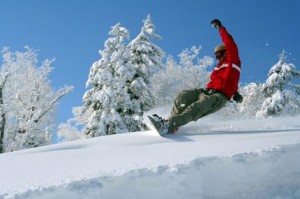While similar in many ways, skiing and snowboarding do have their differences. These sports variety greatly when it comes to the type of injury typically sustained by participants. Conditioning for Skiing requires speed, strength, balance and flexibility. Snowboarding requires similar conditioning however, the way the body moves in both sports is fundamentally different. This difference tends to result in very different injuries in each sport. 
Common Injuries
Skiing tend to result in more knee injuries. The typical skiing injury involvestorque-type injuries to the knees and lower extremities. This twisting of the upper leg one way, while the lower leg rotates the opposite way, often results in tears to the anterior cruciate ligament (ACL).
In snowboarding, both feet are strapped onto the same board and always point the same direction. This protects the knee from any twisting. However, the upper-extremity is in the position to take the force of a fall. When snowboarders fall, they land on their hands, shoulders, rear-ends, or heads. The most typical snowboarding injury is a wrist fracture. There are also wrist sprains and elbow contusions and dislocations, and a lot of contusions and rotator cuff injuries in the shoulder. Broken collarbones, concussions, and other head and neck injuries are common, too.
Rotator cuff injuries in the shoulder are usually treated more conservatively with strengthening programs, anti-inflammatories for contusions and swelling, and rest for the general healing process. Intermittent application of ice (10 minutes three or four times a day) can be helpful in reducing pain, swelling, and inflammation. If a snowboarder attempts dangerous maneuvers — in the trees, going off jumps, and doing tricks — helmets are worth considering.
Injury Prevention
Snowboarders, especially those just starting out, would be wise to stock up on some Safety Gear. Wrist and elbow guards can ease the force of falls on the joints of the upper body. Knee pads help prevent contusions, a pad for the tailbone is also a good idea, as new snowboarders spend a lot of time on their backside. To protect the shoulders from falls, it isn’t a ad idea to learn a bit about its’ anatomy and function ( for more information, read Shoulder Saving Tips).
Finally, although both skiing and snowboarding happen in the snow on a mountain they are very different in terms of technique. Keep in mind that just because you are a good skier, you may be a novice on a snowboard. Taking a lesson from a qualified instructor or an experienced snowboarder is a good idea for the beginning snowboarder. It will make your time on the mountain much more enjoyable.
